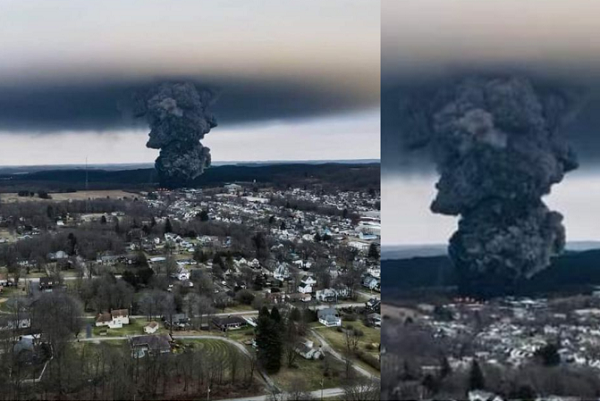ANALYSIS: East Palestine “controlled explosion” released carcinogenic dioxins and a WWI choking agent
03/08/2023 / By Ethan Huff

A new assessment by independent researchers has determined that the air quality in East Palestine contains “unusually high” levels of toxic chemicals, including dioxins and a choking agent that was used during World War I.
Contradicting an earlier report by the Environmental Protection Agency (EPA) declaring East Palestine air to be safe, the new report from researchers at Texas A&M University and Carnegie Mellon University identified “higher than normal” concentrations of at least nine potentially harmful chemicals:
– Acrolein
– Benzene
– Vinyl chloride
– Butadiene
– Naphthalene
– O-xylene
– Trichloroethylene
– Trichloroethane
– P-xylene
Many are describing this toxic plume as “Ohio’s Chernobyl,” and for good reason: these chemicals in isolation, let alone in aggregate, are linked to cancer and a host of other serious health problems. (Related: The dioxin plume created during the controlled explosion in East Palestine is believed to be the largest ever.)
Acrolein is East Palestine’s biggest concern, study finds
Of primary concern in and around East Palestine, according to the new study, is acrolein, a gas that can cause excess fluid build-up in the lungs. This clear, colorless gas or pale yellow, “strong-smelling” liquid was detected at the highest level above safe limits compared to all the other chemicals.
“It evaporates easily at normal temperatures, producing toxic concentrations, and is poisonous when consumed, no matter whether the exposure route is inhaled or through skin contact,” one report explains about acrolein.
“It causes inflammation and irritation of the skin, respiratory tract and mucus membranes. After it is inhaled, it can cause delayed pulmonary edema – excess fluid in the lungs … This can lead to coughs, chest pain and fatigue. It is formed when fossil fuels are burnt and is also a by-product of fires.”
One local mother named Ayla Antoniazzi told CNN that she initially sent her four-year-old back to preschool following the incident, only to have to pull the child right back out after she developed symptoms associated with acrolein poisoning.
“She went back for two days and developed another rash her hands and started complaining of itching, so I pulled her back out,” Antoniazzi said.
Benzene is another noxious chemical similar to acrolein that is either a colorless gas or a pale-yellow liquid that burns easily and evaporates into the air quickly. Benzene is linked to drowsiness, dizziness, increased or irregular heartbeat, headaches, confusion, unconsciousness, and potentially even death.
The EPA reported a median of 0.00084 (mg / m3) of benzene in East Palestine, while the Texas A&M researchers detected 0.03 mg / m3.
Butadiene, another chemical released during the controlled explosion, targets the central nervous system. It can lead to blurred vision, vertigo, tiredness, decreased blood pressure, headache, nausea, decreased pulse rate, and fainting.”
“The long-term health effects of butadiene exposure are unclear and disputed,” reports explain.
“Multiple disease studies in humans have demonstrated an increase in cardiovascular disease and cancer, but due to other factors such as smoking and simultaneous exposure to benzene, scientists cannot be sure of a true causal relationship.”
Naphthalene, a hydrocarbon gas, usually occurs as a white solid substance but can also be a gas when released from a pressurized container. The main route of exposure is through breathing in contaminated areas in homes or other buildings.
The controlled explosion caused the release of naphthalene, which is linked to brain and liver damage when ingested or taken in through skin contact.
“It is also associated with hemolytic anemia, a disorder where red blood cells are destroyed or altered so they cannot carry oxygen, which can lead to organ damage,” reports explain.
“Long-term exposure has been reported to cause cataracts and damage to retinas in the eyes.”
Want to keep up with the latest news out of East Palestine? You can do so at Disaster.news.
Sources for this article include:
Submit a correction >>
Tagged Under:
Carcinogenic, chemicals, choking agent, clean air, clean water, controlled explosion, derailment, Dioxins, disaster, East Palestine, EPA, ohio, poison, poisons, research, toxins, train
This article may contain statements that reflect the opinion of the author
RECENT NEWS & ARTICLES
COPYRIGHT © 2017 SCIENTIFIC NEWS




















